battery TOYOTA YARIS HATCHBACK 2013 Owner's Manual
[x] Cancel search | Manufacturer: TOYOTA, Model Year: 2013, Model line: YARIS HATCHBACK, Model: TOYOTA YARIS HATCHBACK 2013Pages: 403, PDF Size: 8.93 MB
Page 245 of 403
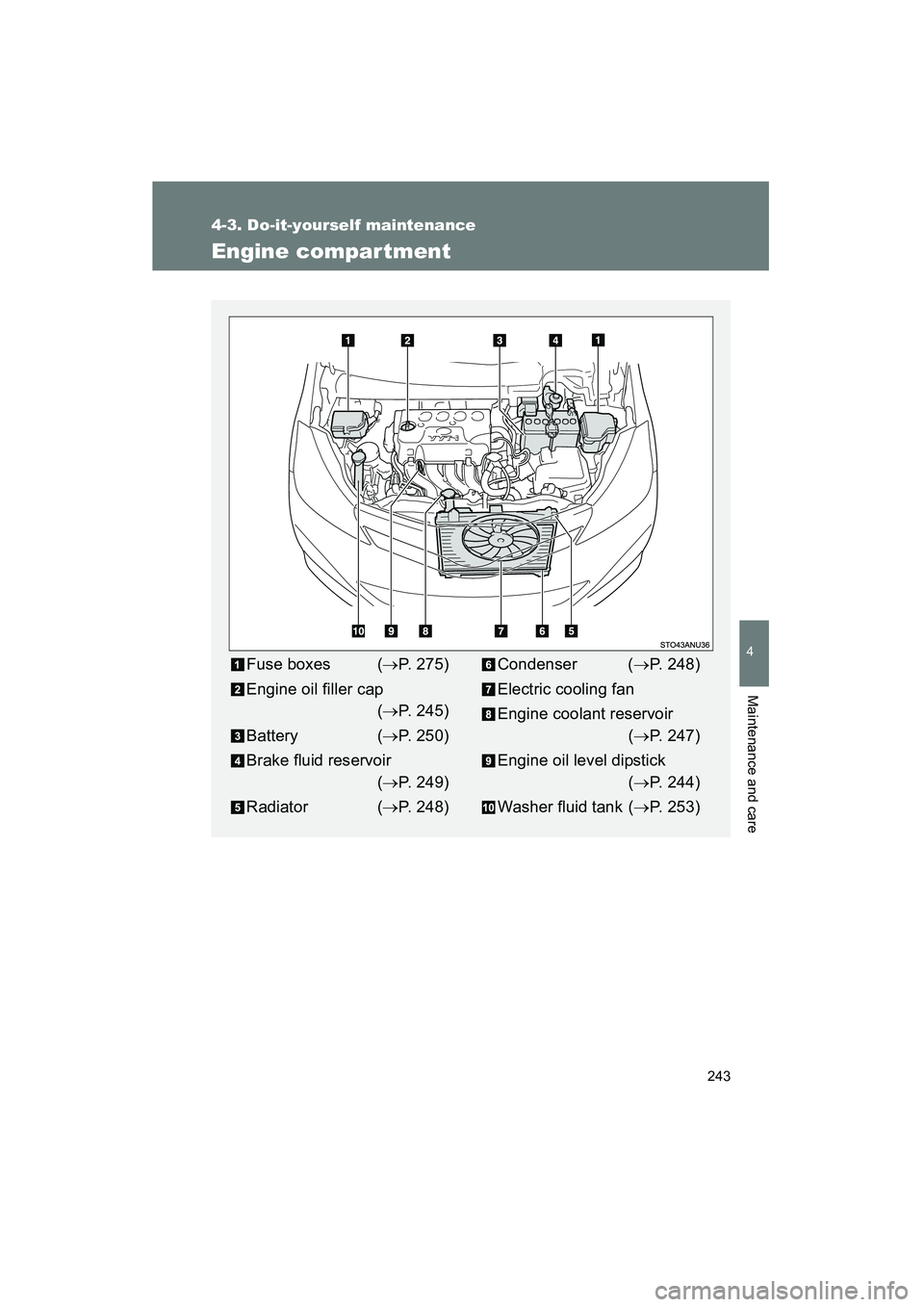
243
4-3. Do-it-yourself maintenance
4
Maintenance and care
YARIS_HB_U_52D44U
Engine compar tment
Fuse boxes (→P. 275)
Engine oil filler cap (→P. 245)
Battery ( →P. 250)
Brake fluid reservoir (→P. 249)
Radiator ( →P. 248)Condenser ( →P. 248)
Electric cooling fan
Engine coolant reservoir (→ P. 247)
Engine oil level dipstick (→ P. 244)
Washer fluid tank ( →P. 253)
Page 252 of 403
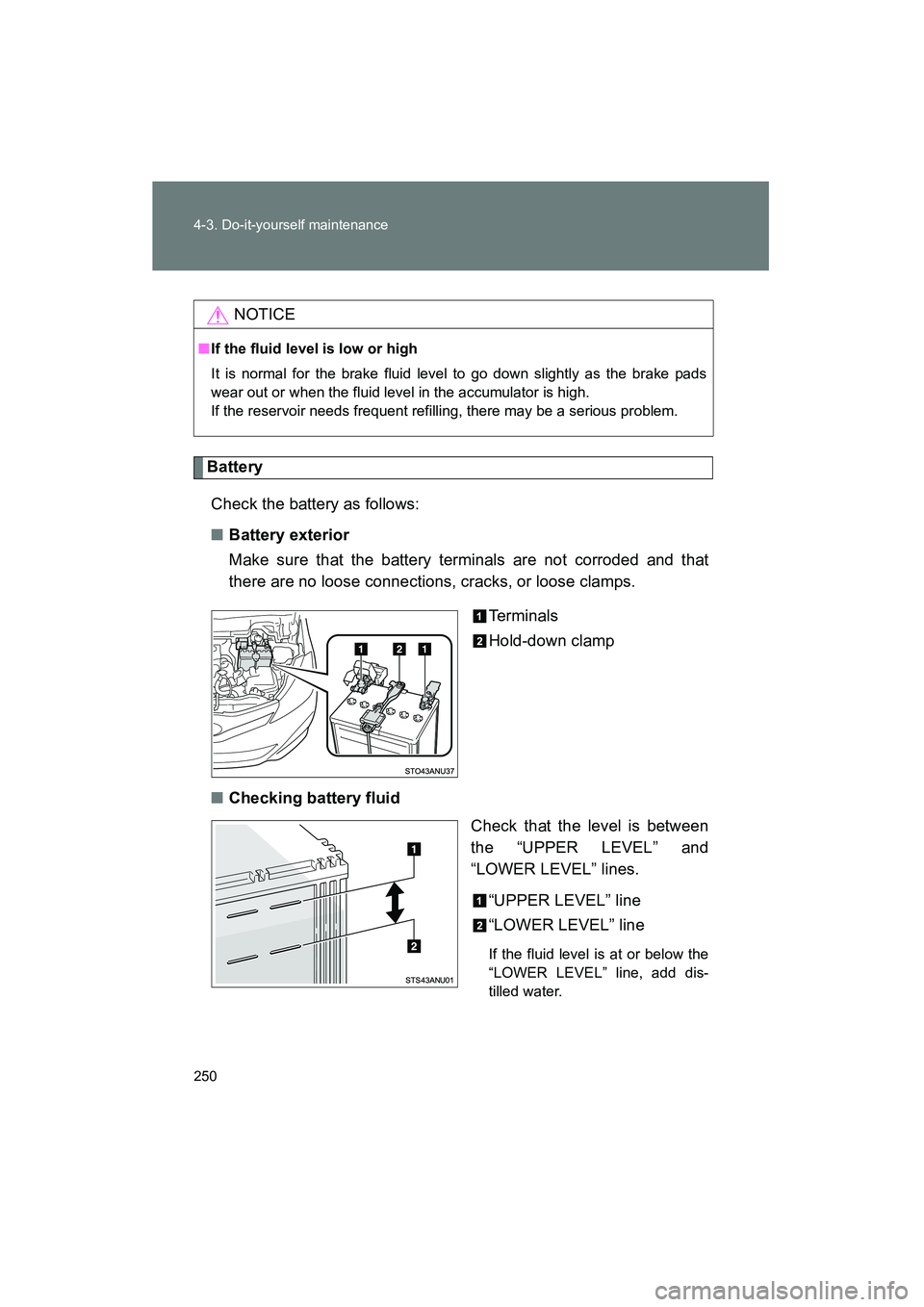
250 4-3. Do-it-yourself maintenance
YARIS_HB_U_52D44U
BatteryCheck the battery as follows:
■ Battery exterior
Make sure that the battery terminals are not corroded and that
there are no loose connections, cracks, or loose clamps.
Te r m i n a l s
Hold-down clamp
■ Checking battery fluid
Check that the level is between
the “UPPER LEVEL” and
“LOWER LEVEL” lines.
“UPPER LEVEL” line
“LOWER LEVEL” line
If the fluid level is at or below the
“LOWER LEVEL” line, add dis-
tilled water.
NOTICE
■If the fluid level is low or high
It is normal for the brake fluid level to go down slightly as the brake pads
wear out or when the fluid level in the accumulator is high.
If the reservoir needs frequent refilli ng, there may be a serious problem.
Page 253 of 403
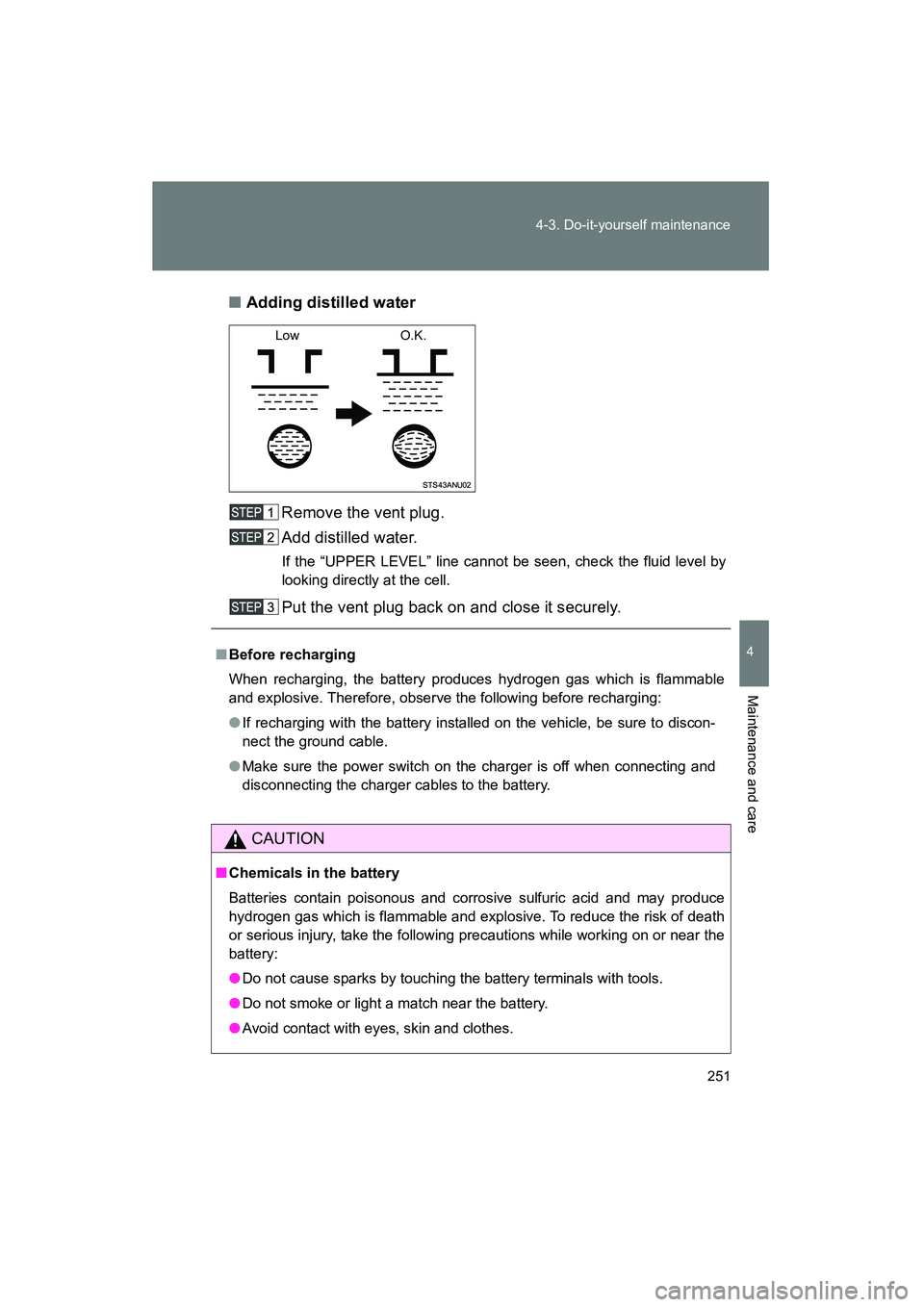
251
4-3. Do-it-yourself maintenance
4
Maintenance and care
YARIS_HB_U_52D44U
■
Adding distilled water
Remove the vent plug.
Add distilled water.
If the “UPPER LEVEL” line cannot be seen, check the fluid level by
looking directly at the cell.
Put the vent plug back on and close it securely.
Low O.K.
■Before recharging
When recharging, the battery produces hydrogen gas which is flammable
and explosive. Therefore, observe the following before recharging:
●If recharging with the battery installed on the vehicle, be sure to discon-
nect the ground cable.
● Make sure the power switch on the charger is off when connecting and
disconnecting the charger cables to the battery.
CAUTION
■Chemicals in the battery
Batteries contain poisonous and corrosive sulfuric acid and may produce
hydrogen gas which is flammable and explosive. To reduce the risk of death
or serious injury, take the following precautions while working on or near the
battery:
●Do not cause sparks by touching the battery terminals with tools.
● Do not smoke or light a match near the battery.
● Avoid contact with eyes, skin and clothes.
Page 254 of 403
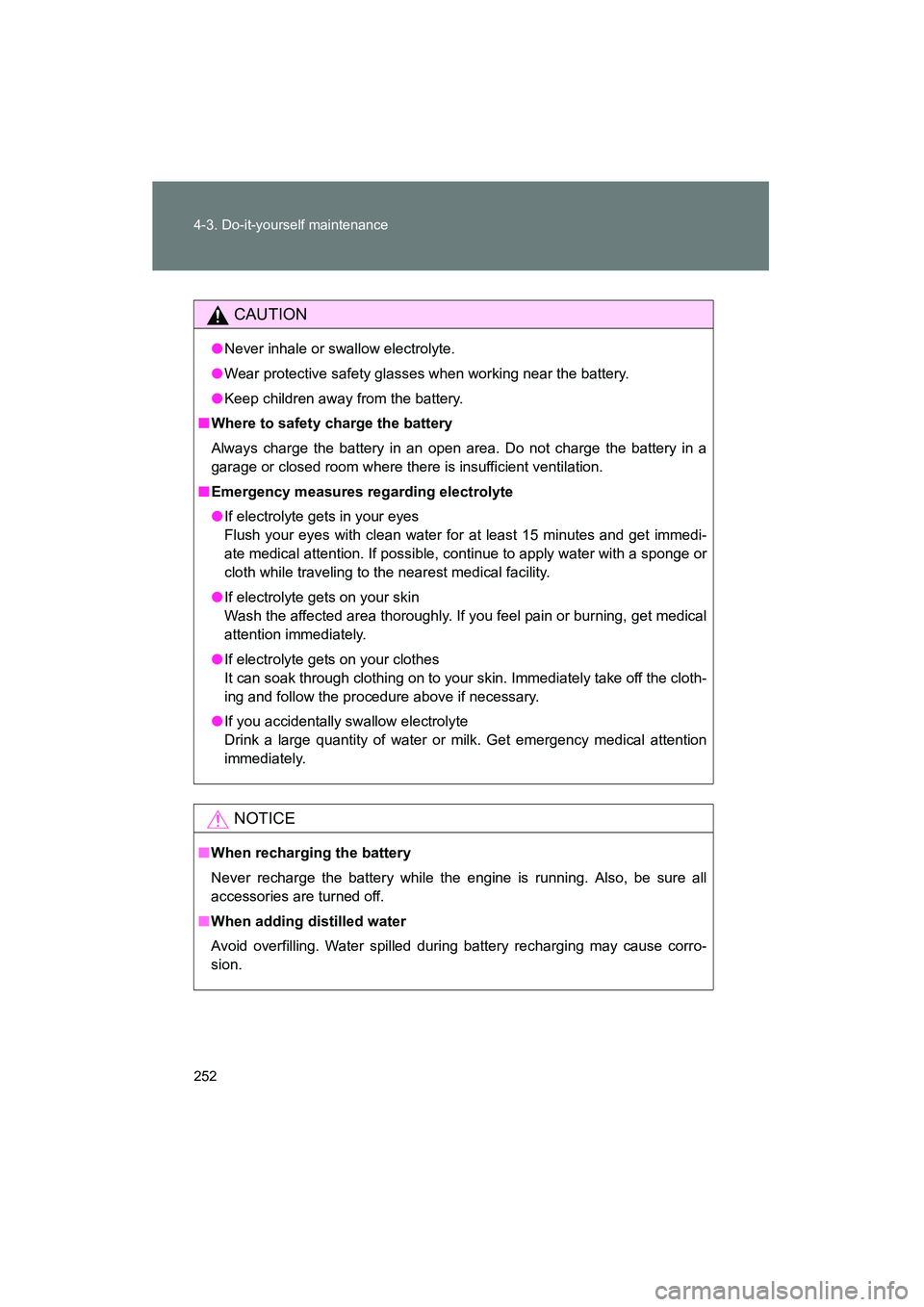
252 4-3. Do-it-yourself maintenance
YARIS_HB_U_52D44U
CAUTION
●Never inhale or swallow electrolyte.
● Wear protective safety glasses when working near the battery.
● Keep children away from the battery.
■ Where to safety charge the battery
Always charge the battery in an open area. Do not charge the battery in a
garage or closed room where ther e is insufficient ventilation.
■ Emergency measures regarding electrolyte
● If electrolyte gets in your eyes
Flush your eyes with clean water for at least 15 minutes and get immedi-
ate medical attention. If possible, continue to apply water with a sponge or
cloth while traveling to the nearest medical facility.
● If electrolyte gets on your skin
Wash the affected area thoroughly. If you feel pain or burning, get medical
attention immediately.
● If electrolyte gets on your clothes
It can soak through clothing on to your skin. Immediately take off the cloth-
ing and follow the procedure above if necessary.
● If you accidentally swallow electrolyte
Drink a large quantity of water or milk. Get emergency medical attention
immediately.
NOTICE
■When recharging the battery
Never recharge the battery while the engine is running. Also, be sure all
accessories are turned off.
■ When adding distilled water
Avoid overfilling. Water spilled during battery recharging may cause corro-
sion.
Page 273 of 403
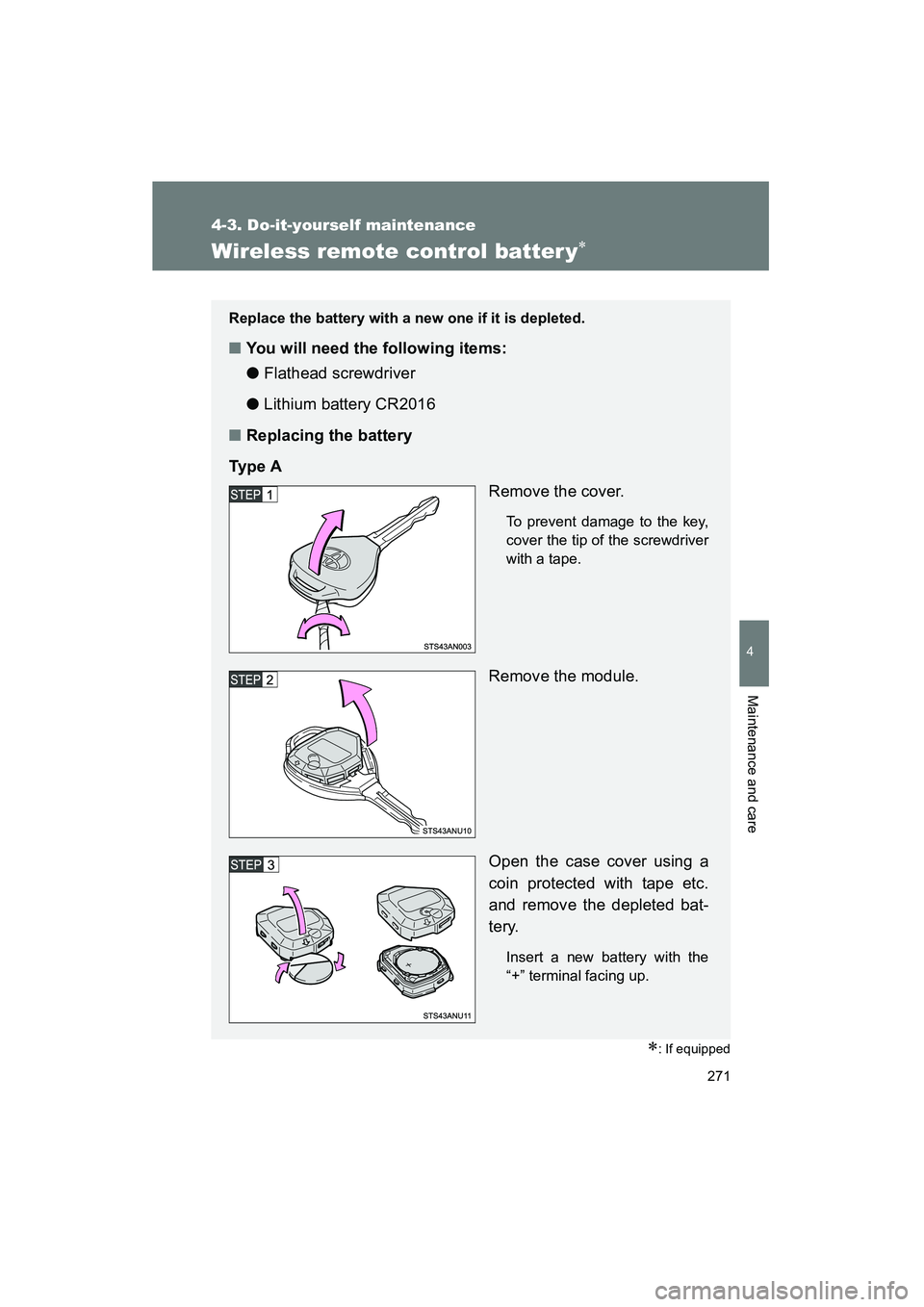
271
4-3. Do-it-yourself maintenance
4
Maintenance and care
YARIS_HB_U_52D44U
Wireless remote control batter y∗
∗: If equipped
Replace the battery with a new one if it is depleted.
■You will need the following items:
● Flathead screwdriver
● Lithium battery CR2016
■ Replacing the battery
Ty p e A Remove the cover.
To prevent damage to the key,
cover the tip of the screwdriver
with a tape.
Remove the module.
Open the case cover using a
coin protected with tape etc.
and remove the depleted bat-
tery.
Insert a new battery with the
“+” terminal facing up.
Page 274 of 403
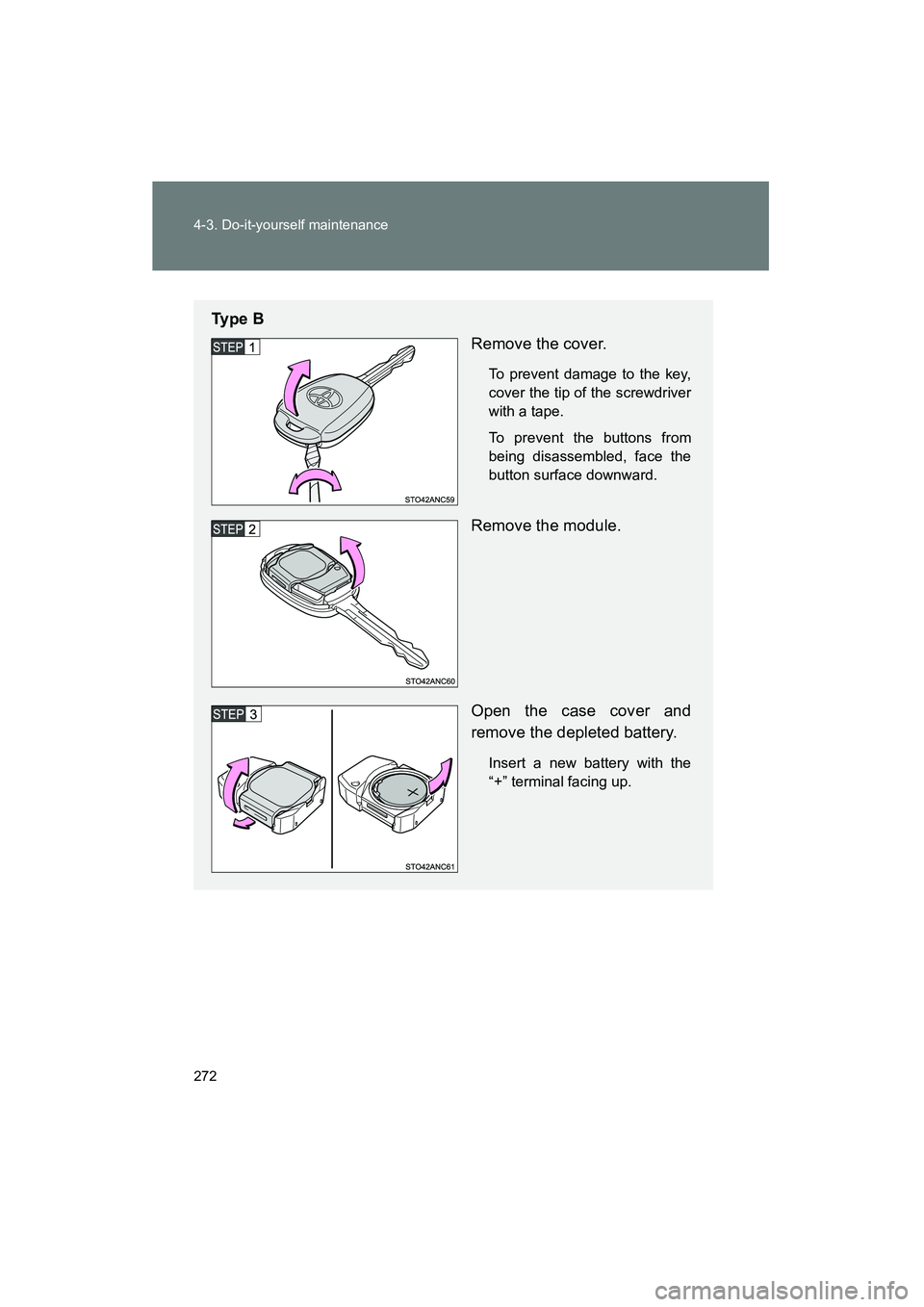
272 4-3. Do-it-yourself maintenance
YARIS_HB_U_52D44U
Ty p e BRemove the cover.
To prevent damage to the key,
cover the tip of the screwdriver
with a tape.
To prevent the buttons from
being disassembled, face the
button surface downward.
Remove the module.
Open the case cover and
remove the depleted battery.
Insert a new battery with the
“+” terminal facing up.
Page 275 of 403
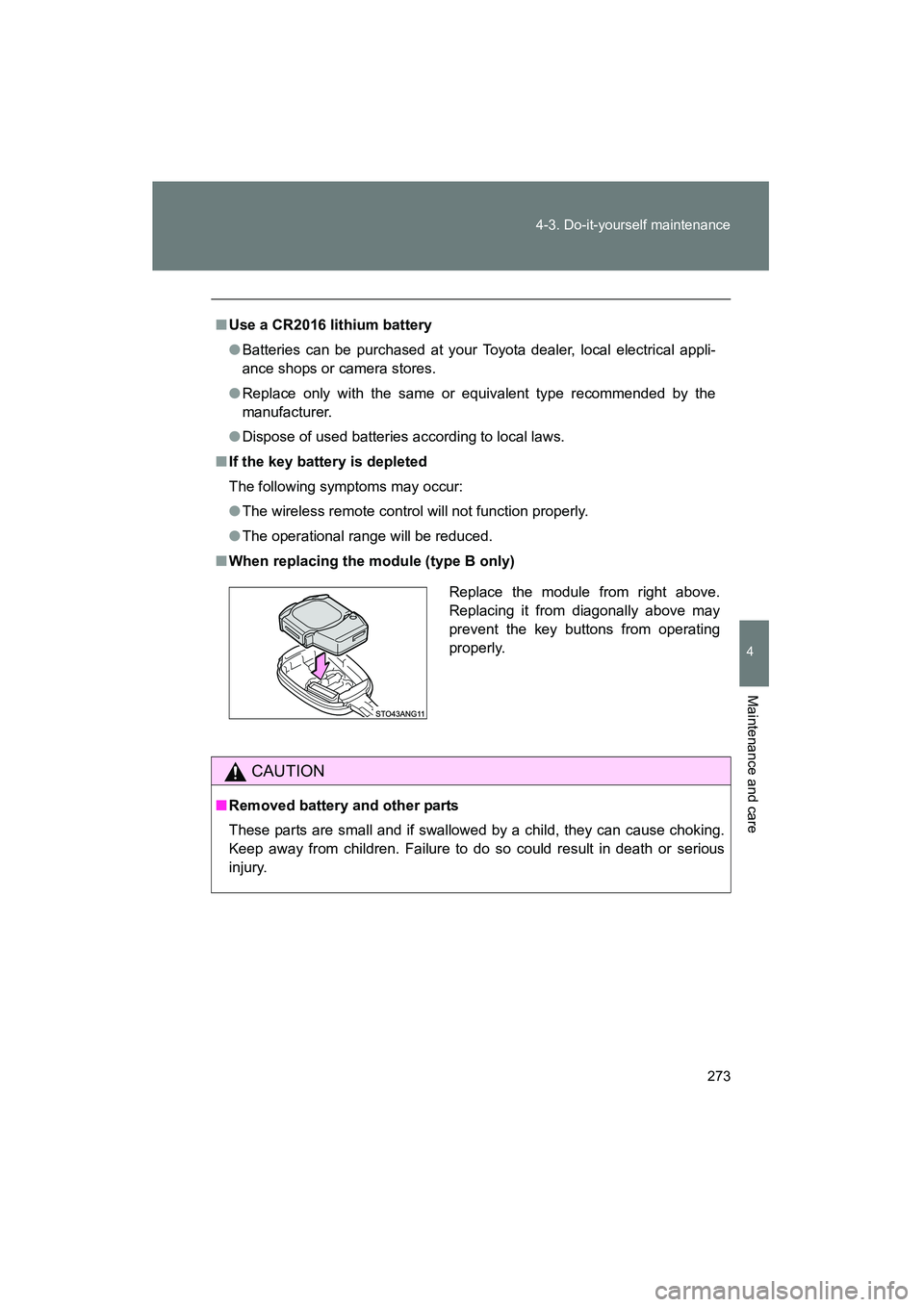
273
4-3. Do-it-yourself maintenance
4
Maintenance and care
YARIS_HB_U_52D44U
■
Use a CR2016 lithium battery
●Batteries can be purchased at your Toyota dealer, local electrical appli-
ance shops or camera stores.
● Replace only with the same or equivalent type recommended by the
manufacturer.
● Dispose of used batteries according to local laws.
■ If the key battery is depleted
The following symptoms may occur:
●The wireless remote control will not function properly.
● The operational range will be reduced.
■ When replacing the module (type B only)
CAUTION
■Removed battery and other parts
These parts are small and if swallowed by a child, they can cause choking.
Keep away from children. Failure to do so could result in death or serious
injury.
Replace the module from right above.
Replacing it from diagonally above may
prevent the key buttons from operating
properly.
Page 276 of 403
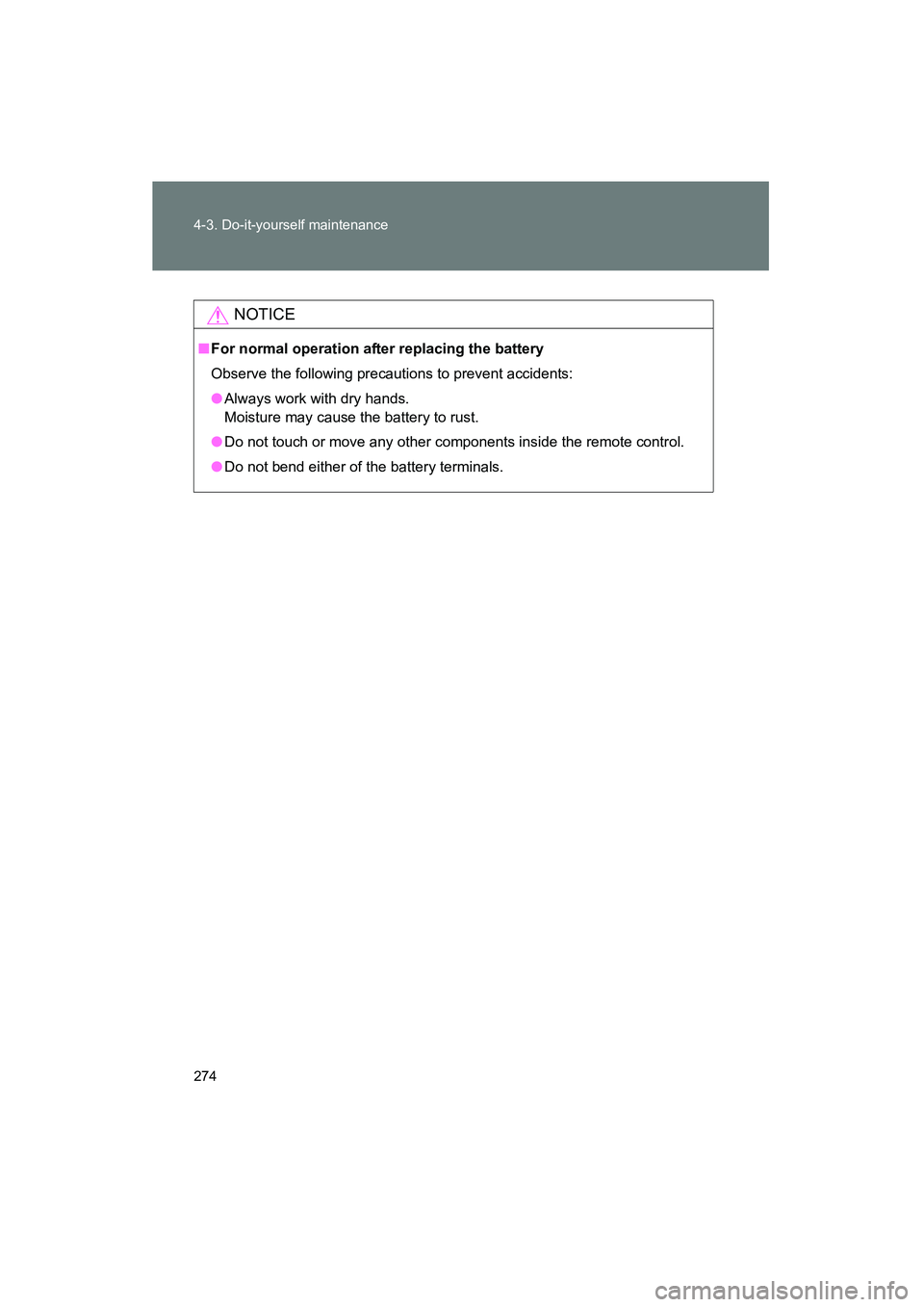
274 4-3. Do-it-yourself maintenance
YARIS_HB_U_52D44U
NOTICE
■For normal operation after replacing the battery
Observe the following precautions to prevent accidents:
● Always work with dry hands.
Moisture may cause the battery to rust.
● Do not touch or move any other components inside the remote control.
● Do not bend either of the battery terminals.
Page 278 of 403
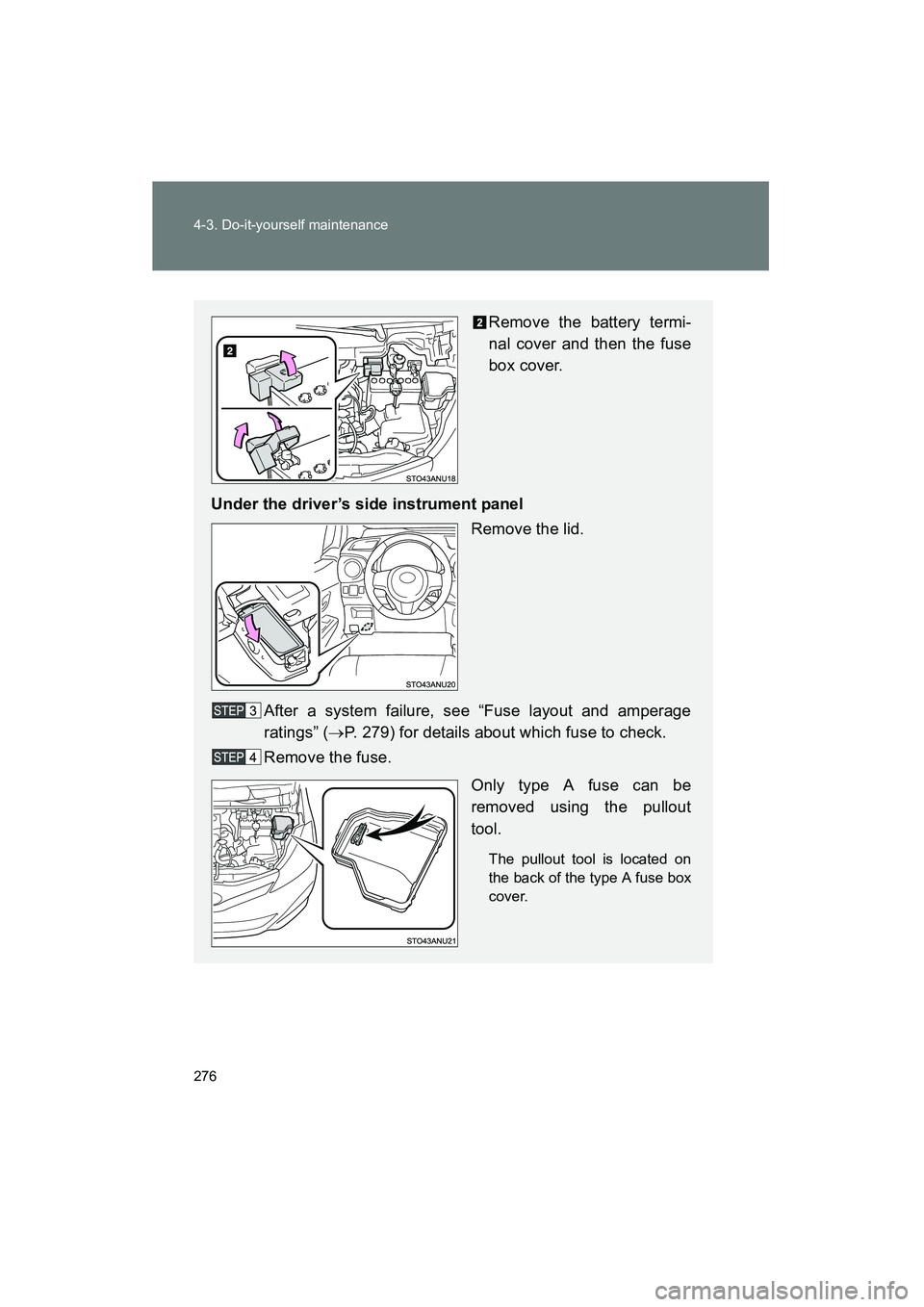
276 4-3. Do-it-yourself maintenance
YARIS_HB_U_52D44U
Remove the battery termi-
nal cover and then the fuse
box cover.
Under the driver’s side instrument panel Remove the lid.
After a system failure, see “Fuse layout and amperage
ratings” (→ P. 279) for details about which fuse to check.
Remove the fuse.
Only type A fuse can be
removed using the pullout
tool.
The pullout tool is located on
the back of the type A fuse box
cover.
Page 297 of 403
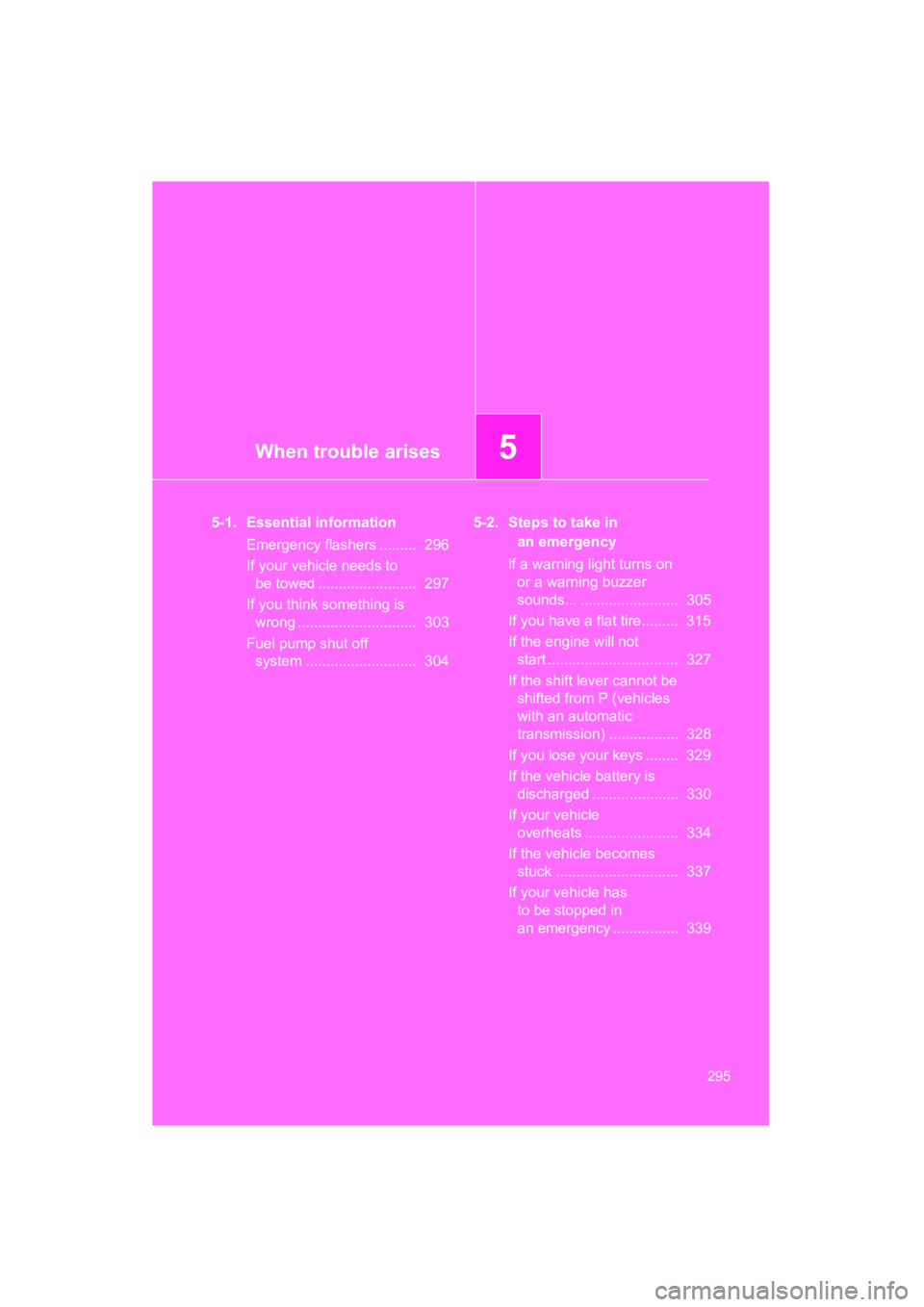
When trouble arises5
295
YARIS_HB_U_52D44U
5-1. Essential informationEmergency flashers ......... 296
If your vehicle needs to be towed ........................ 297
If you think something is wrong ............................. 303
Fuel pump shut off system ........................... 304 5-2. Steps to take in
an emergency
If a warning light turns on or a warning buzzer
sounds..
......................... 305
If you have a flat tire......... 315
If the engine will not start ................................ 327
If the shift lever cannot be shifted from P (vehicles
with an automatic
transmission) ................. 328
If you lose your keys ........ 329
If the vehicle battery is discharged ..................... 330
If your vehicle overheats ....................... 334
If the vehicle becomes stuck .............................. 337
If your vehicle has to be stopped in
an emergency ................ 339